But China and the tax havens like Luxembourg, oh my!
US corporate debt, excluding debt by banks – so “nonfinancial” corporate debt – has surged in recent years by all measures and to such an extent that it was featured prominently in the Fed’s Financial Stability Report, in terms of what might trigger the next financial crisis. The Fed is counting total nonfinancial business debts, which include the debts of businesses that are not incorporated. It found about $17 trillion in debts.
A narrower measure is nonfinancial corporate debt, which amounts to $15 trillion. This is up a breath-taking 40% from the prior peak in 2008. The Bank for International Settlements (BIS) uses this measure to compare how corporate debt stacks up in different countries. One of its measures is corporate debt denominated in local currency; and in order to determine the relative size of this debt, the BIS expresses it as a percent of nominal local-currency GDP. So Chinese debt in yuan as a percent of Chinese GDP in yuan. By this measure, the US nonfinancial corporate debt-to-GDP ratio has ballooned to the highest ever: a stunning whopping 73.9% of GDP:
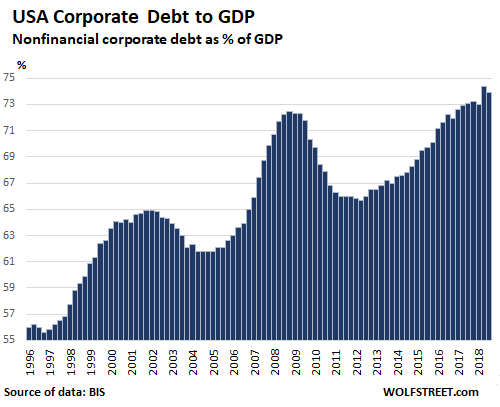
But the US is only in 25th Place
The BIS also converts local-currency debt to dollars, so that the total debts can be compared from one country to another. And the US corporate debt of $15 trillion pales compared to China’s corporate debt of $19.7 trillion.
But that is down from the $21.1 trillion in Q1 2018, at which point Chinese authorities got serious about deleveraging the corporate sector. The monstrous pileup of corporate debt in China happened in just 12 years:
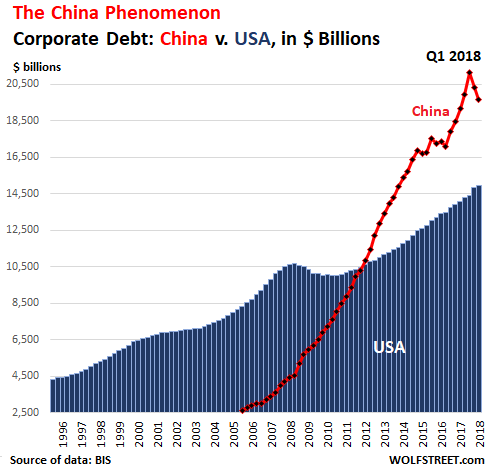
China’s economy, while growing much faster than the US economy, is still quite a bit smaller than the US economy, when measured by GDP in US dollars. And so among the larger economies, China’s corporate-debt-to-GDP ratio is unrivaled (though there are some small economies with special tax laws that blow right past China for other reasons, and we’ll get to those in a moment). The data for China goes back only to 2006. Note the effects of China’s efforts to deleverage its corporate sector, with corporate debt-to-GDP ratio now down to 152.9%:
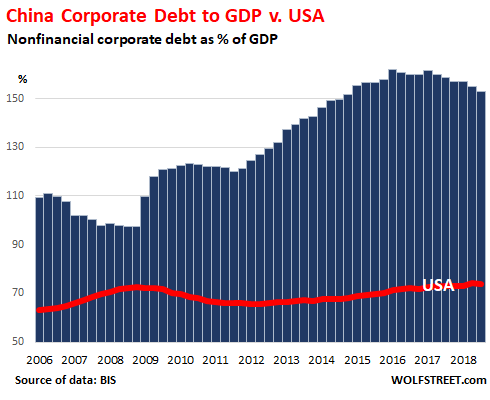
But China is only in 7th Place by debt-to-GDP
The tax-haven syndrome mucks up the numbers. Ahead of China in terms of the corporate debt-to-GDP ratio are a gaggle of small countries that are in effect tax havens for global corporations, including US companies whose debts start showing up in Ireland and elsewhere because that’s where they’re suddenly headquartered. Number one is tiny Luxembourg. There are five of those countries ahead of China, plus Sweden, which leaves China in 7th place.
So here we go with out debt countdown:
#24: Australia corporate debt-to-GDP ratio: 74.7%
Australia is a notch ahead of the US, with a corporate debt-to-GDP ratio of 74.7%. Because the differences between countries are so huge, it is impossible to put the charts on the same scale. To keep a sense of perspective, I added a red line for the US in each chart, and as we go down the line-up, and as the corporate debt-to-GDP ratio balloons country by country, we will see that red line getting pushed lower and lower until it is just an insignificant little thing at the base of the chart.
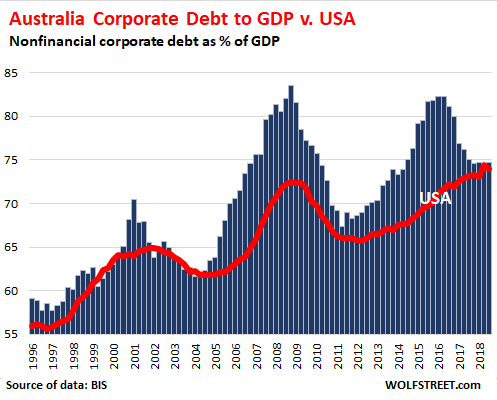
#23 Turkey corporate debt-to-GDP ratio: 80.3%
Turkey is already in the middle of a crisis that is composed of a currency crisis, an inflation crisis (20%), and a debt crisis. Much of the debt in Turkey is denominated in foreign currency, mostly euros and dollars, and so inflation in Turkey just makes the debt-service burden worse. After a blistering surge of corporate debt over the past few years, the corporate debt-to-GDP ratio of Turkey finally beat that of the US in 2018, at 80.3%:
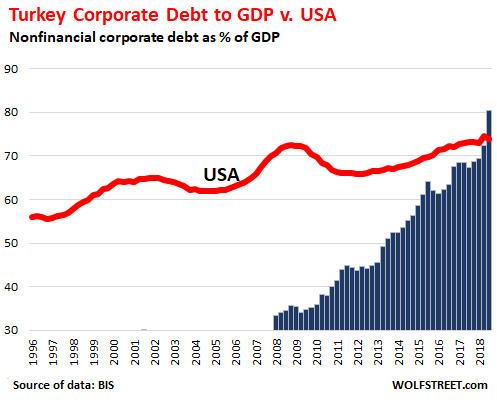
#22 United Kingdom corporate debt-to-GDP ratio: 83.3%
The UK debt-to-GDP ratio has been high for years, and is in part related to the City of London as a tax haven for global corporations. But 83.3%, it’s down from 101% at the beginning of the Global Financial Crisis:
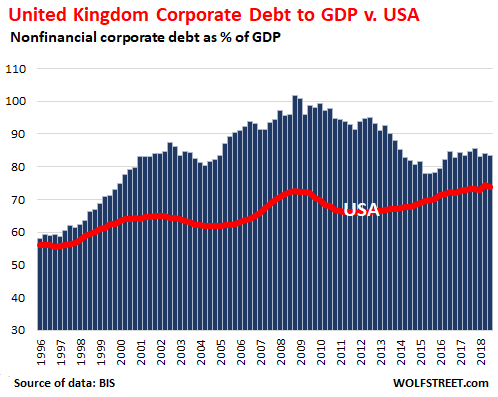
#21 New Zealand corporate debt-to-GDP ratio: 83.8%
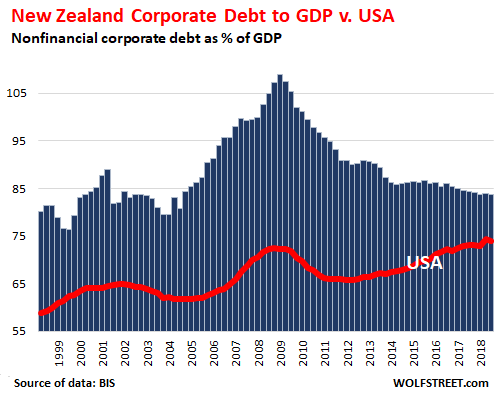
#20 Austria corporate debt-to-GDP ratio: 89.9%
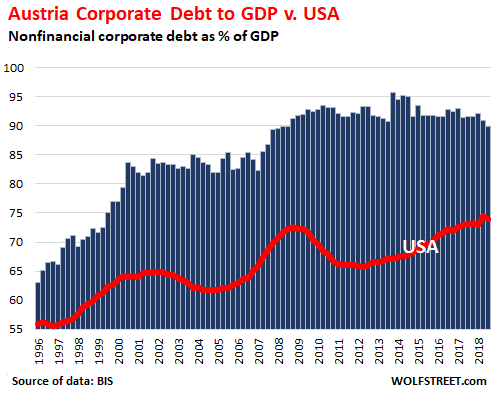
#19: Spain corporate debt-to-GDP ratio: 93.7%
Note the deleveraging that has taken place since Spain’s brutal financial crisis during the euro debt crisis. This is an exemplary chart of what leads to a financial crisis and how it gets resolved:
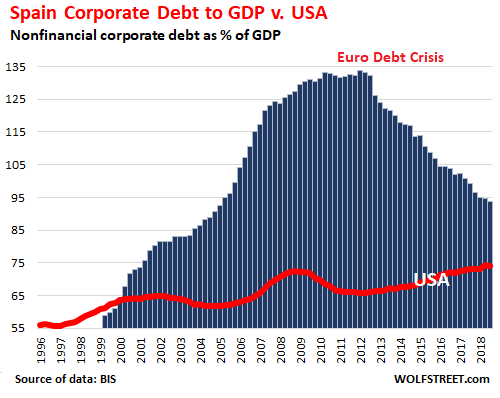
#18 Chile corporate debt-to-GDP ratio: 96.3%
The data goes back to only 2003.
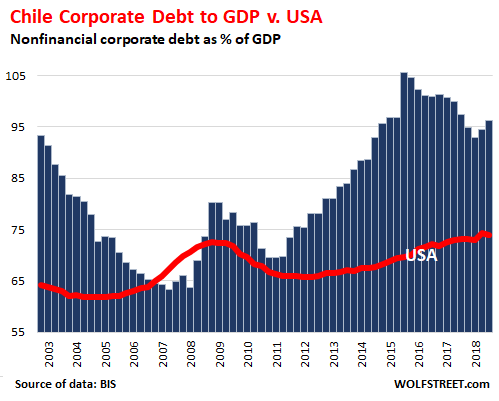
#17 South Korea corporate debt-to-GDP ratio: 101.2%
And the effects of the Asian Financial Crisis that kicked off in 1997 are perfectly visible:
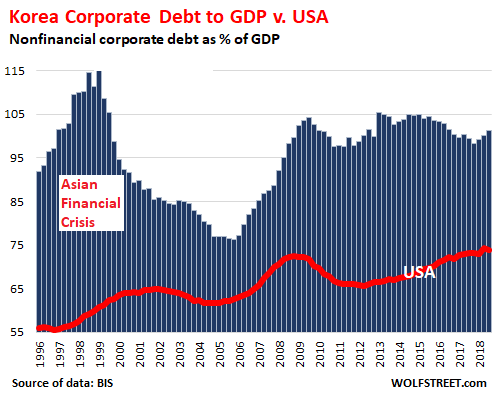
#16 Japan corporate debt-to-GDP ratio: 101.2%
Japan’s corporate sector deleveraged for over 15 years from its world-class debt bubble that imploded in 1989:
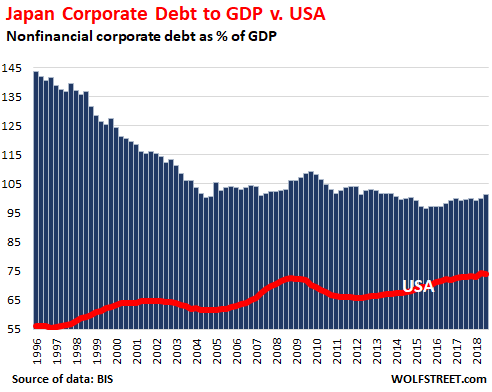
#15 Portugal corporate debt-to-GDP ratio: 101.4%
A financial crisis, such as Portugal’s or Spain’s, always ends the same: pain and forced deleveraging (defaults or otherwise). And there is still some deleveraging left to do.
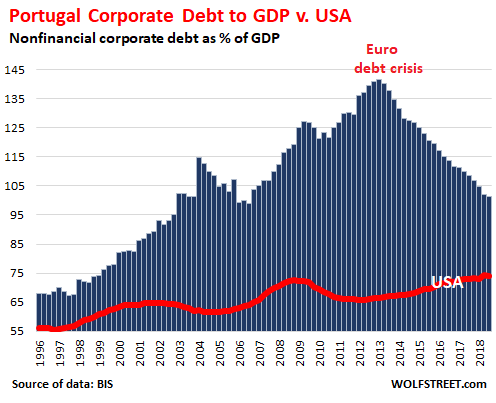
#14 Denmark corporate debt-to-GDP ratio: 111.8%
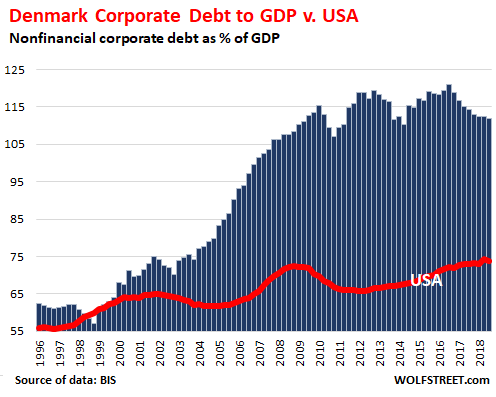
#13 Canada corporate debt-to-GDP ratio: 113.2%
Canada is of course noted for its household debt that ranks among the highest in the world. But it’s also doing a good job in the corporate sector.
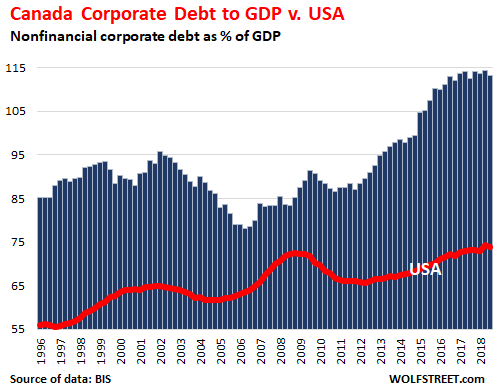
#12 Singapore corporate debt-to-GDP ratio 114.9%:
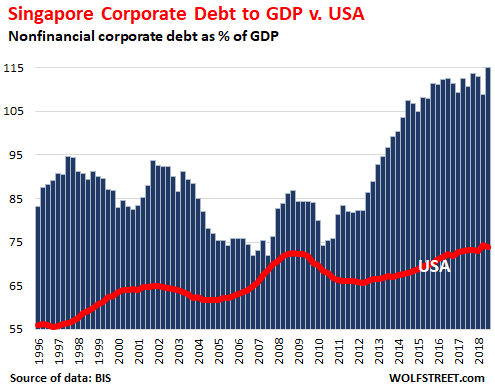
#11 Finland corporate debt-to-GDP ratio 115.1%:
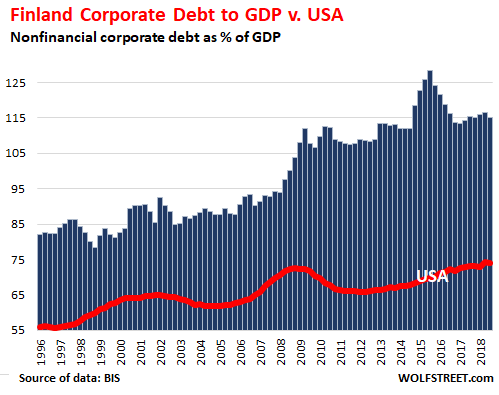
#10 Switzerland corporate debt-to-GDP ratio 118%:
The data for Switzerland only goes back to 2000.
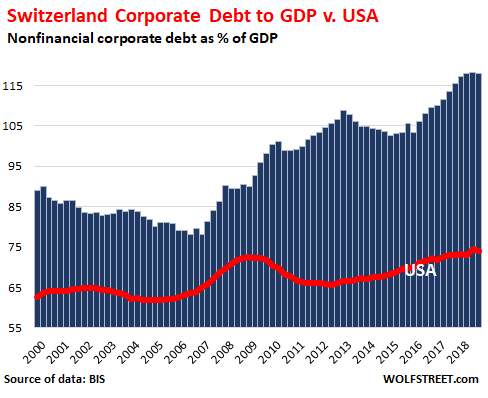
#9 Norway corporate debt-to-GDP ratio 135.4:
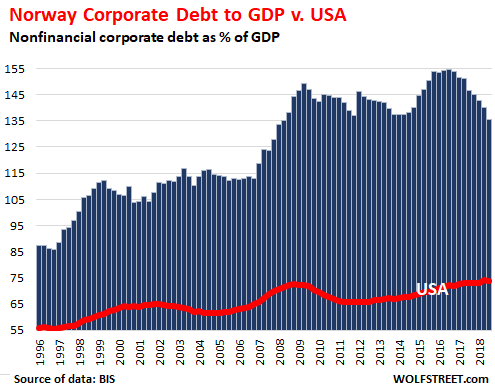
#8 France corporate debt-to-GDP ratio 143.6%:
As is the case in some other countries, the French corporate sector is dominated by enterprises that are either wholly or partially owned by the state and that used to be entirely owned by the state before being partially privatized. They have enormous amounts of debt, which is assumed to be backed by the French state.
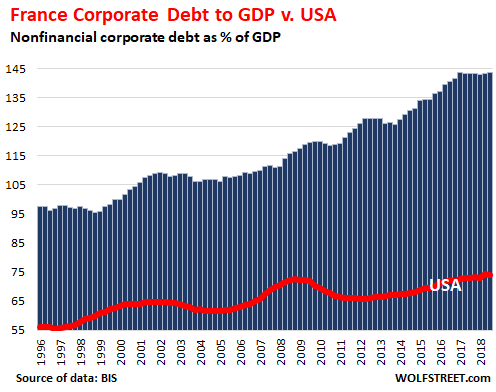
#7 China corporate debt-to-GDP ratio 152.9%:

#6 Sweden corporate debt-to-GDP ratio 158.2%:
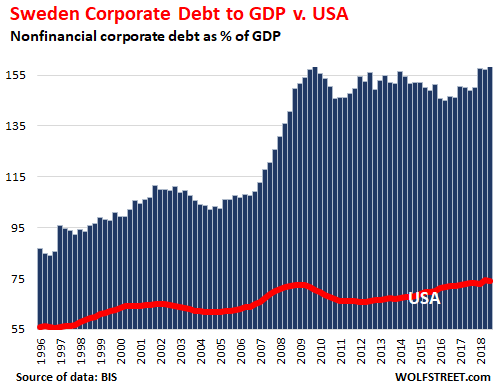
#5 Belgium corporate debt-to-GDP ratio: 161.1%
Belgium is the location of Euroclear that holds about $32 trillion in assets in fiduciary accounts and it has come other advantages for global corporations.
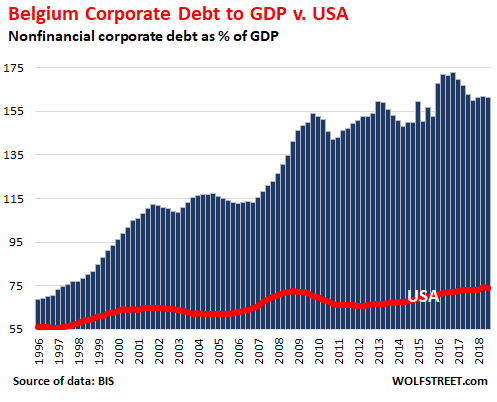
#4 Netherlands corporate debt-to-GDP ratio: 170.8%
Now we’re getting into the smorgasbord of corporate tax avoidance techniques — delicious sounding menus items like “double Irish with a Dutch sandwich” — for large corporations that might impact where and how their debts are registered.
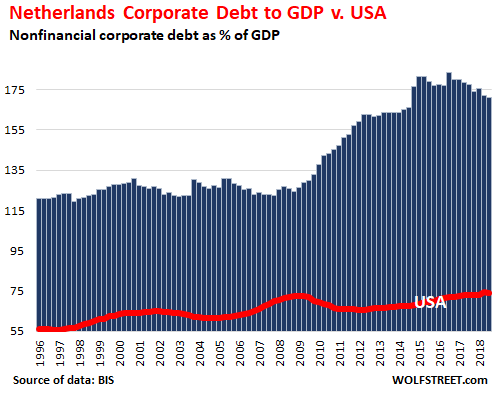
#3 Ireland corporate debt-to-GDP ratio: 195.3%
The hottest thing for US corporations was to engineer a move to Ireland on paper, to dodge US taxes. One of these maneuvers is a corporate tax inversion. For example, Allergan, a pharmaceutical giant that generates most of its sales in the US, was formed in 2015 when Irish–registered Actavis acquired the much larger US company and assumed Allergan’s name. Note the fabulous spike in Ireland’s corporate debt-to-GDP ratio at that time. Actavis, formerly a US company as well, had performed the same feat in 2013. These companies didn’t actually move to Ireland, but now at least some of their corporate debt shows up in Irish data — instead of in the US data:
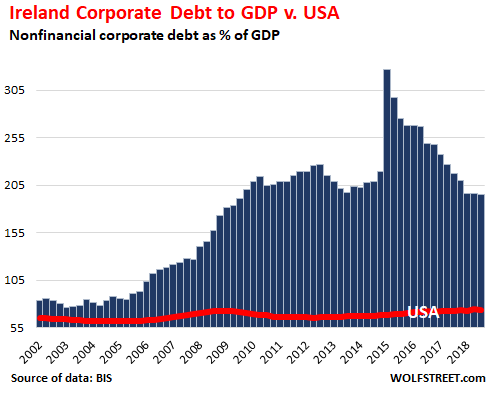
#2 Hong Kong corporate debt-to-GDP ratio: 222.9%
This is where China’s corporate debts like to hang out. And much of it should be added to China’s tally.
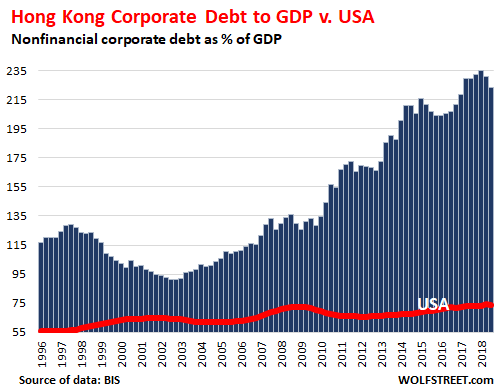
#1 Luxembourg corporate debt-to-GDP ratio: 222.9%
“Many companies, regardless of their industry or origin, have already made the choice to locate their headquarters in Luxembourg like ArcelorMittal, the world’s largest steelmaker, RTL Group, the European leading radio and TV broadcaster, satellite services leaders SES and Intelsat, intercontinental airfreight company Cargolux, or internet giants Amazon, Skype and Paypal,” brags the Luxembourg office of KPMG whose business it is to manage mailbox headquarters. Which explains this:
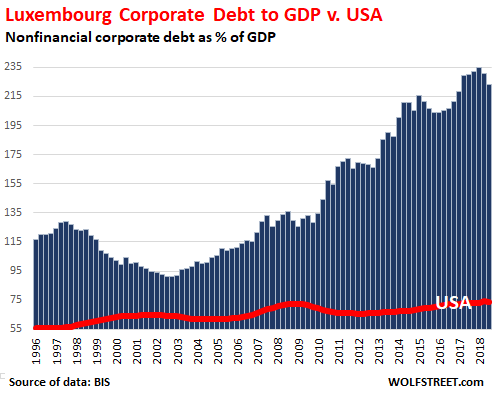
And this concludes another chapter in the amazing global debt saga.
And where do consumers fit in? Read… State of the World’s Biggest Debt Slaves: Americans Wimp Out in 11th Place
Enjoy reading WOLF STREET and want to support it? You can donate. I appreciate it immensely. Click on the mug to find out how:
![]()


Outstanding piece Wolf!
Three minor typos:
Australia: … and as we go done the line-up…
UK: … it’s down from 201%… (I believe you meant 101%)
Portugal: …such as Portugal’s of Spain’s…
In spite of the hair-rising figures, there seems to be a nearly infinite appetite for debt. In the US, the demand for the 10y Treasury has managed to invert the yield curve.
So the question is: what happens when interest on the debt becomes the biggest outlay in the budget? What will get cut? Entitlements? Defense? School lunches?
Thanks for the typo alerts. I think your last question is a rhetorical question. This varies country by country. But in the US, Defense won’t be cut. It’ll be everything else first.
Is noted that US is”nonfinancial” corporate data.
What about all the other countries? Are those data
also nonfinancial? Cannot see the reasoning for such comparison. Debts of financial institutions are also debts. Maybe leverage of financial insitutions can be turned into assets as and when needed.
Yes, all data in these charts are based on the same measure of “nonfinancial corporate debt” to GDP ratio, measured in local currency both for the debt and GDP, which eliminates the exchange rate issues.
There is another very interesting data set:
Government Debt to GDP: https://tradingeconomics.com/country-list/government-debt-to-gdp
After you’ve descended from the airy heights of Japan at 253.5% and located the USA at 119.3%, search out the one advanced country that is most nearly debt free. Even if the measure of GDP is a fiction drawn out of some politician’s nether regions, the differences are startling.
Looks like the US sanctions have been hard at work helping Russia diversify its economy, as Russia is nearly debt free at 13.5% of GDP. I wonder which country would be most likely to survive a global financial collapse and remain solvent?
Tang, the reason why non financial corporations have to be excluded is because inside the financial system there are gazillions of dollars in offsetting transactions. When XYZ Corp (non financial) takes out a loan from ABC Bank, often ABC bank raises the $ for the loan by borrowing from a contortium* of other banks. But those banks in turn get a slice of XYZ’s loan payments, so there’s really only the one loan plus a bunch of offsetting arrangmeents. In other cases the other banks are borrowing from ABC. If one counts every single loan without the offsetting relationships, the accounting only explains how contorted the financial system has gotten, but not how indebted people actually are. Knowing how intertwined the banks have gotten is not quite the same thing as knowing whether the productive economy has promised to repay more than it can deliver.
* “Contortium” was originally a typo but after looking at it I think it’s actually the best word to explain a system that works via financial contortions!
It’s always interesting to mention “the country that shall not be mentioned” in a conversation with Americans. Notice how not a single poster felt that Russia’s lack of debt @13.5% GDP was of interest when compared the the US or Japanese national debt.
A later poster said: “Only the US can print the world’s reserve currency.” Perhaps he should tell that to the Russians, Chinese, Iranians, (and now Italians?) who are increasingly using their large acquired gold reserves to build a multi-lateral exchange system of their own currencies to trade vital items like oil?
The US policy has historically been to squash any upstart country foolish enough to challenge dollar hegemony. When Qaddafi tried to establish a gold-based African trading system for oil he received a bayonet up his ass, accompanied by mad cackling from Secretary of State Hillary Clinton (https://www.youtube.com/watch?v=FmIRYvJQeHM).
Doesn’t work so well when countries are as powerful as Russia.
Maduro had 1.2 billion dollars of Venezuelan gold reserves held in the Bank of England for international trade collateral seized/stolen, closing all doors except the one to the Russian/Chinese trading block. After multiple CIA assassination attempts upon the elected presidents Maduro and his predecessor Chavez, the US still hasn’t succeeded in driving the bayonet home and reviving the flow of heavy oil to the Koch refineries. Any US plans for an invasion and cost free bombing joy ride may have been thwarted by an oil-for-S300 exchange— no dollars needed. Looks like the old methods of supporting the dollar as reserve currency are starting to collapse.
Again, we see that the US is the new Rome: as the dying emperor said to his sons ‘Take good care of the army ,and stuff everyone else.’
I do hope that includes taking great care of those who lost their limbs, and spouses and children, not just the contractors?
Yes, the definition of insanity is to spend, spend, spend on the military when there is no real military threat to the U.S. Meanwhile, the infrastructure and schooling falls further behind our competitors.
(You know you’re spending too much on the military when everyone is LOOKING for a place to use it. That was Iraq then. It’s Iran and even Venezuela, if you believe Trump, now.)
I’d further wonder if people think Rome mainly fell because its military failed.
Most scholars think it failed because it allowed it’s working class to be pillaged by cronies and soon-to-be local monarchs, all for private gain.
Hows That been working out from all of them..Lately…comical,were it not so tragic,aloha
So defense stocks that preferably pay a dividend are the safe harbor ?
So well, Boeing, a big defense contractor that has recently gone on sale, pays a div yield of 2.3%, even after having gone on sale, worse than 1-month to 1-year Treasuries. So if you just want to hang on to your money and earn 2.3%, go to Treasuries or CDs or even high-yield savings accounts. This way you don’t lose money when something goes wrong. In a general market sell-off, defense contractors sell off too. Nothing is protected. Boeing lost over 50% during the last last big selloff (2007-09).
If you want to buy something that appreciates in value, then that’s a different story. And it’s worth taking some risks for that.
Hi Old Dog. I read a piece over the weekend from someone who sounded qualified to voice an opinion. His suggestion….” A Soft Default ” for the US. via a substantial devaluation of the dollar. The least bad option he called it. So maybe the intentionfor the US is to max out their credit card and then in the dark of night move to plan “A”. For anyone interested in economics and finance it’s a very interesting time to be alive.
Excellent Article!
Would like to point out China is likely the first in reality due to fiction CPP peddles… There M1 Growth declined even by there numbers in February, after a 4 Trillion Yuan printing month in January, if you print 5 % of GDP in one month, and your M1 declines the next month, you have serious delinquencies happening or capital outflow problems ( likely both in China ).
On a side note, Chinese Banks had 120 Billion RMB ( 18 Billion US ) delinquencies in January alone with about 3.5 Trillion RMB Maturity in 2019… With 30 % defaults at best case and 45-50 % worst case, China’s corporate defaults will be between 157-260 Billion US for 2019… Q2 will be very interesting
Or people give each other stuffed red envelops with Chinese new year which get deposited in February.
China Central bank will bail out the Chinese banks and the corporate debt.
That is the new playbook for Central Banks,
Here we look at debt as percentage of GDP as ability to sustain a debt., meaning sufficient income and assets to support amortisations and interest in case interest rates reach a higher level e.g. 5%. i am pretty sure this country ranking will look pretty different.
Now lets sort by those with the most derivatives exposure ;)
But reality. How many countries GDP nos are inaccurate?
A bigger GDP no. reduces the percentage. Most gov. knows. And of course the manipulation goes on.
If the real gdp nos are given. Then all hell breaks loose.
You are correct. And the US’s GDP number is total BS. Much higher than reality; therefore a much lower debt/GDP ratio that makes everyone feel good. I don’t know about other countries GDP numbers, but they are probably manipulated also.
The current reality for the US is we are close to debt saturated again. Doesn’t matter what the ratio is. Same with rest of world. Slowdown/stall is inevitable except that the US has the ability to print and borrow without immediate effects to the economy. But the inflation will come as we’re seeing now with the effects of QE 7-10 years ago.
The Coming Crisis the Fed Can’t Fix: Credit Exhaustion
March 18, 2019
https://www.oftwominds.com/blogmar19/exhaustion3-19.html
You make a good point. A large slice of U.S. GDP is government deficit spending used to pay people to perform unproductive work. The job of many a government worker is to show up (at least 3 or 4 days/week) and spend every cent of their paycheck, comfortable in the knowledge that a government pension will take care of them in retirement – in effect the job of these people is to take the money given to them and spend it into the economy. Paying people to do unproductive work is a misallocation of debt. We are stuck with this debt, it must be paid off in inflation, but we are left with no useful infrastructure or public commons. This is counted as GDP but it’s not sustainable, in fact it is a net long term negative and a legacy/burden Boomers are passing on to Millennials. Given the money the government (we) borrow we should have state of the art infrastructure or at least efficient affordable mass transit, what we have instead is a giant ugly mess, deteriorating roads crammed with gas guzzling SUVs and a bloated and hungry military sucking ever larger sums of debt and looking for new places to invade.
GDP indeed. Well done America!
Van: Well sadly Canada’s socialists are proving they can suck better than even the best! That is a prize I don’t want!
Scandinavian social welfare experiment ends up with greater corporate indebtedness – someone has to pick up the tab for freebies. EU has the worst case scenario of breaking up judging from the various basket case economies & their NIRP/QEs which have not help their indebted corporations at all. North Asian export oriented economies ultimately uses increasing corporate debt to subsidize/fund their export growth. Tax havens are just proxies for International Corporations to park their funds from the taxman or as a mailbox address for M&A ventures – they don’t generate any real wealth for the tax haven economy except for a select few. Just look at HK & S’pore, the property prices are just ridiculous, extremely artificial & are dependent on the next greater fools to keep the game going. The banks there are so flushed with cash that they lend to any Chan, Wong & Li willing to put their necks on the chopping board.
Debt is the answer to those questions of the various economic & corporate experiments for the 25 economies listed. Corporations these days simply kick the can down the road for future taxpayers to pay their bills, destroy shareholders wealth gradually while the corporate management reap the largest share of corporate profits, rort benefits to their advantage & shaft the shareholders/bondholders. No wonder Warren Buffett is facing his own Age of Extinction.
Or the Scandinavian system is better, which leads to more multinationals so you have more debt.
I will guess that much of corporate debt in Norway is due to very large capital intensive industry. Specially oil and shipping.
Is it fair to say the world is at peak debt?
It’s more like a pit.
If it’s not deep enough, the banks can be flexible about credit limits.
If this wasn’t really serious, I’d be laughing.
Think about this, a company that used to produce something tangible, usable that more or less enhanced the lives of the user.
This company goes public, a,b and c buy shares in this company, the company uses this money to create a better product and grow.
Now comes the role of the ( regulator)
This bastard sleeps on the wheel for threes decades or more, wakes up to find;
A hedgfund played havoc in these ( companies shares value) result = total destruction of the company,the product and the share holder value.
A bank or a pension fund manager ( without any reasonable idea about the actual value of the company’s product pours billions of dollars into that company’s share, result = over inflated value and over indebted company (i e it’s being hijacked by dumbass financiers to further their profile as genius wizards!)
and on and on it goes,
So now we have a share market that represents an overvalued piece of crap that consists mainly of financials that add no value to the economy ( bar them being parasites and leeches living on the brow- sweat of the real producers).
So here we are at this moment in history where the ( Custodians of the rule of law and the governments responsible for the welfare of their citizenry have elevated themselves far buoyed the RULED, to the detriment of this latter group)
What could we do?!
robespierre Would have a very intelligent answer to this very question!!!
Alas he’s being dead for centuries :)
To what extent do these ratios reflect the smaller % of equity, and the larger role of long term bank financing in their capital structure?
Bank financing is included.
Great article Wolf. Crazy amounts of debt. UK debt could almost be split City of London-UK. Two separate countries in reality. Regards Steve, UK.
Very interesting….but
it means nothing.
Why do i say that?
Because they’ll wind up doing the same thing the US did and just transfer the debt load to their gov’ts, who don’t have to worry about paying back debt…because they “can always print it”. Just like the US.
And when the gov’t has all the debt the central banks in those countries will ‘ drive rates to zero’, so there is no cost, and engage qe from the central banks to also lighten the load on the gov’t.
Yes, i know it’s just deferring the problem for another (x) amount of years until there’s a currency crisis. But that is what they will do and you and i and anyone else who’s paid the least amount of attention knows it.
Only the US can print the world’s reserve currency. If anyone else tries to just print, the currency collapses. There are only 17 fully convertible currencies in the world (Barclays) and a bunch that are worthless outside the country. They can print all they like but they can’t buy anything.
In all these countries the main task is to get hold of a real or even sort of real currency. This applies inside the country. No one wants the local money. See Zimbabwe and Venezuela for two extreme examples but there are many. Where the state prohibits other currencies there is the black market and barter.
A symptom of coming collapse is the high denomination note.
In Zimbabwe they had a hundred million (or something) note.
Even in Italy before the euro there was a 500, 000 lira note.
Major purchases like real estate were priced in US$.
Of course as you indicate, even the US can’t just print forever.
Is there any way to disaggregate this all, as in by nation of corporation, properly back to country of origin…. I mean that is where most people live, not on the global corporate stage.
?
As France was mentioned a day or so ago, I had been looking at why its private debt was so high, it isn’t really state capitalist like China, actually I am not sure if it has very much capitalism left beyond corporate , either way this slightly outdated look gives a hard analysis, it is using a different debt to gdp series to the above for whatever reason
http://www.privatedebtproject.org/view-articles.php?What-s-the-Matter-with-France-The-French-Corporate-Private-Debt-Binge-2008-2016-30
“That means that companies that are listed as non-financial, with regards to French national accounting, are actually acting much like a financial institution that would use leverage to multiply its returns on investment. Moreover, by borrowing, they are pushing up the demand for assets and contributing to the asset bubble, both domestically and abroad.
In this regard, the link between the rise in French corporate borrowing and the rise in global stock markets since the 2008-09 financial crisis can be seen as a classical example of the transmission channel between interest rates and asset prices at work. Low-interest rates make it attractive for investors to borrow to buy assets on financial markets. This, of course, creates financial market risk—that asset prices will fall and losses on borrowed money will be incurred. In the case of French companies pursuing this strategy, the risk is actually greater because it would not only reinforce but magnify the transmission channel of a potential financial crisis from the financial sector to Main Street – or to the “real economy.” ”
And how many French companies are accounting out in Luxembourg on top of this? The trouble with France as per that article is that it hasn’t even tried to deleverage unlike just about every other major country, and has little to show for it.
Ray Dalio had this great theory about local and foreign denominated debt busts causing deflation or inflation, respectively.
There are many lessons to learn from Iceland.
Like the wisdom of jailing bankers instead of subsidising them.
When GM (for example) builds a plant in China and borrows in China to finance it, does that show up as U.S. corporate debt, or Chinese?
Looks like Spain and Portugal are really hammering away at their debt, Ireland too down around a third. Good for them.
They been hammerin away since Euro2000, now they hammerin away at government debtedness an sweepin under carpets cause its all got some cause like eunuchification. In old days they been hammerin away too but every money was uniqueness by hand an yu dont be gettin more real-ness than that.
https://ibb.co/gZFC1zR
What Alfonso el Africano goin to be think of Junckers is no sure but he probably be kickin his buttiness, an in Spain they probably go to kickin an hammerin each other if they not figurin out how to who is charge of where what why when.
I am a cynic to the core and am wondering, as more and more business sectors are revealed to be hollowed out shells, how much of this new debt is last man out the door asset stripping?
We are down in the Bahamas for a few weeks and there seems to be no shortage of mega-yachts. The local and traditionally corrupt government just made a big show of “reform” in their notorious money laundering banks. I am really cynical about that one…….
Loved visiting the “banks” in Gran Cayman. Row after row of post office boxes, each housing the corporate headquarters of a Global Corporation.
Crazy Horse: I am very disappointed to find out that there are not any large expensive bank glass windows down there for me to throw my borrowed rock through to boost GNP!
As the wise man said,
“any fool can borrow money, but only the clever ones can pay it back”
OC
You got it backwards. The clever borrowers don’t pay their debt. They shift it to the foolish ones :)
I think that’s probably working on a national level as well!
Greece , Argentina just examples of that genius trend :)
Off course soon to be followed by multitudes!
I’m entertaining certain theories:
1) CEOs don’t care about debt. It’s not like it’s their money, and besides, they have huuge incentives to max out the company plastic.
2) The global banking cartel owns the world. They’ll let you use it, but it’s going to cost you.
3) The world is bankrupt. It just hasn’t been notified yet.
4) If it’s timed correctly, the sheer mass of mounting debt will cause the Earth to collapse into a black hole at the same time catastrophic climate change makes it uninhabitable. Call it profit maximization.
5) Non-financial debt owed to the plantary ecosphere is hopelessly in default and liquidation is the only recourse.
CEO’s only care about two things:
Cash flow & stock price level.
And those two items only because they influence the size of their Bonus.
Cash flow? Most CEO are more interested in generating accounting profits meaning the non-cash flow type. M&A generates the greatest amount of “goodwill” which is reflected in the accounts & are done using shares – hardly any cash involved.
It is harder to generate “real” cash flow because the global economy is “Sh**e”. The market these days need an inordinate amount of prodigious lending just for Investment & consumption.
Stock buybacks using debt & financial engineering tricks are what keeps stock price levels up. Organic growth isn’t possible in today’s market environment. Just like in professional bodybuilding, an inordinate supply of steroids & HGH are requisites for today’s competition & the cunning ability to avoid a positive drug test.
3) The world is bankrupt. It just hasn’t been notified yet.
5) Non-financial debt owed to the plantary ecosphere is hopelessly in default and liquidation is the only recourse.
3, Without a doubt!
5. No, they will HYPERINFLATE!
OC
6) It is discovered that everyone owes everyone else everything, so starting a mass vogue of once in a lifetime interstellar redemption trips.
I’m thinking all are counting on severe devaluation .
So far they have been right.
Some may wonder why Wolf is always bashing China despite what seems to be very healthy debt levels. To me, that’s because China’s behaviors, whether it is on government, corporate and consumer levels, don’t pass the smell test; and it has not been for the last 7-8 years.
How is Wolf Bashing China ? There financial leaders are some of the dumbest economists that ever lived, that country is so fucked it’s insane how people don’t understand how bad it will get… They will be past Japan lost decade, and will be somewhere around Argentina inflation, total collapse of a nation, total… Investment GDP is 43 % on fake numbers, real is around 50 %, that means HALF of there GDP requires Direct Debt intervention, Haiti is 45 %, think about that… Government deficit is around 10-12 % of GDP… China will lose 25 % of its GDP within 2 quarters peak global recession, likely towards end of year/early 2020… Consumption GDP is low 30s, which is insane, it virtually means the people are too broke to consume anything… I am still young, but I have a hardcore obsession with reading and economics, in all of my life’s reading on macro economics, China today is by FAR the biggest collapse a major economy in modern era will ever see. It’s impossible to top the collapse that is coming to China, it literally isn’t. There sheer amount of Debt Servicing to GDP and Debt Fueled growth in that country is out of this world, it’s almost like half of China’s companies bleed money and would not exist in a regular economy. 18 Billion US Defaults in January itself, if there was 18 Billion of defaults in the US in one month, it would mean Armageddon is coming
They have been trying desperately to stop there recession since beginning 2018 and they can’t… Do you know how bad your financial situation has to be for the Central Bank and Government not being able to stop a recession from getting worst ? I do not think it’s ever happened before in a major economy, yet it’s happening with China… They have cut reserves 5 times, in few weeks 6th time since beginning 2018, cut taxes on absolutely everything they can, governments running a masssssive deficit, everyone is indebted to there tits from consumers to banks and local governments. China is cancelling imports, that’s how bad it is getting, even there fake imports data shows consistent import downtrend… Real GDP per capita is argued to be around 4500-5000 US per person, with government fiction being 9000 US per person… Buddy it’s hopeless, China’s government fucked the country up beyond repair, it’s the definition of live fast die young with mind blowing non stop credit injections since end 2008. People there never bothered to ask where is this credit coming from or why house prices are doubling every 2 years, why are prices on everything so expensive compared to small salaries ? The word Inflation is banned in China, cpp used ” growth ” replace it.
Housing ” Growth ” or Food ” Growth “, vegetables have ” growth ” in China, go figure!
Maybe Wolf could use this as one indicator for his new zombie meter!
I still have that borrowed rock to throw through the biggest most expensive window I can find to boost GNP!
So despite these monstrously high debts, why are the interest rates on the debts so ridiculously low? If the investors viewed these debts as unmanageable, the rates would sky rocket. part of the answer si that the central banks are monetizing the debts. So to some extent these graphs are meaningless and interest rates do not reflect any issues. When does this change? Ho/w long can central banks keep on doing this? Longer than I can live? So why do I care then. Wolf, any thoughts?
Central banks?
Think about it this way, you’ve got a son or daughter, and he/ she is spending your hard earned money left , right and center, you could;
Chastise him and stop giving him pocket money,
Kick him out of the house. And let him deal with his finances!
Or just cop it on the chin and keep feeding his bad behavior!!
The Fed have opted for the last option! I am afraid!
The last Fed option would be sort of parental, as in Dr Frankenstein, or maybe a snake loving its kids – someone has to……. :)
How would the US Corp debt look under GAAP.There is evidence that most US corps are zombies.
Perhaps I don’t understand. The Fed has been depressing rates for 10 years now to stimulate borrowing and now complains there is too much debt?!?!? If all this debt really does lead to a problem, the Fed response will be to lower the rates even more and stimulate more borrowing. Perhaps the next round will be pure MMT.
Is this more bullish for tangible, debt-free assets or assets leveraged to the hilt with soon-to-be devalued currency?
I estimate 40, 50 or maybe more (?) comments here and not a single hint of optimism. I can remember as a child back in the 30s and 40s, periodic broadcasts on the radio (no TV back then) warning that the end of the world was at hand. And then it almost happened on December 7.
But it didn’t, did it……?
Folks read this. Wolfstreet spot on again.
https://www.businesstimes.com.sg/companies-markets/singapore-law-firm-sees-cracks-in-south-east-asias-credit-markets